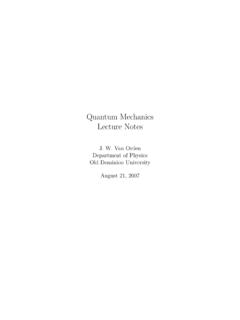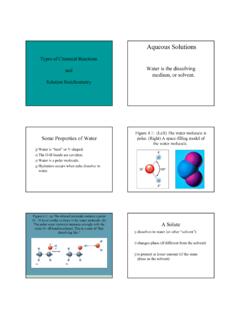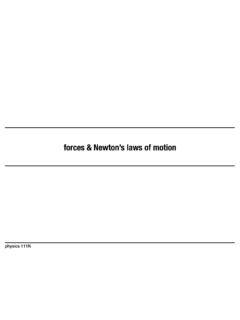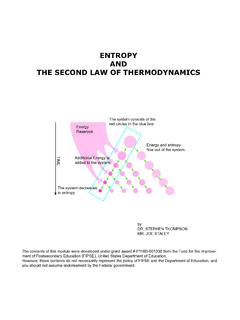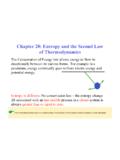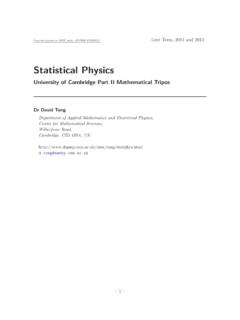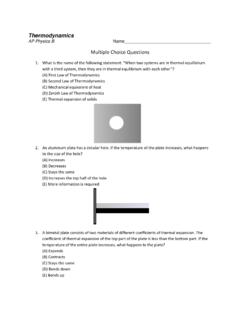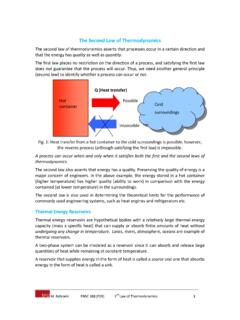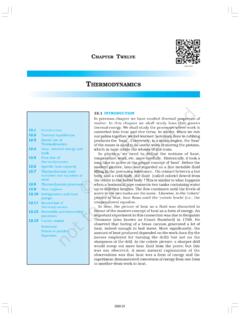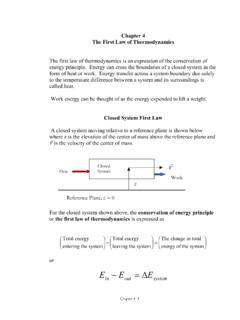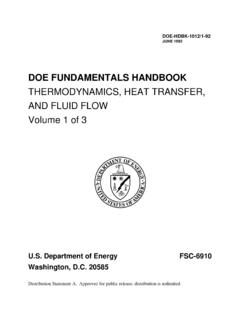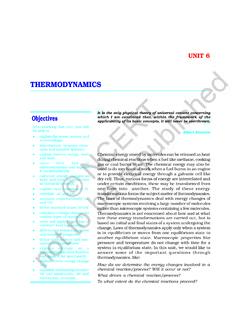Transcription of Spontaneous Processes and Spontaneity, Entropy, Free Energy
1 1 Chapter 16 Spontaneity, Entropy, andFree EnergySpontaneous Processes and EntropySpontaneous Processes and Entropy thermodynamics lets us predict whether a process will occur but gives no information about the amount of time required for the process. A Spontaneous process is one that occurs without outside : The rate of a reaction depends on the pathway from reactants to products;this is the domain ofkinetics. Thermodynamicstells us whether a reactionis Spontaneous based onlyon the properties of the reactants and predictions of thermodynamics do notrequire knowledge of the pathway between reactants and Law of thermodynamics The First Law of thermodynamics states that the Energy of the universe is constant. While Energy may change in form (heat, work, etc.) and be exchanged between the system & surroundings - the total Energy remains constant.
2 To describe the system:Work done by the system is done on the system is evolved by the system is absorbed by the system is and Enthalpy Change In Chapter 6, we tentatively defined enthalpy in terms of the relationship of Hto the heat at constant pressure. This means that at a given temperature and pressure, a given amount of a substance has a definite enthalpy. Therefore, if you know the enthalpies of substances, you can calculate the change in enthalpy, H , for a and Enthalpy Change In Chapter 6, we tentatively defined enthalpy in terms of the relationship of Hto the heat at constant pressure. In practice, we measure certain heats of reactions and use them to tabulate enthalpies of formation, Hof. Standard enthalpies of formation for selected compounds are listed in Appendix and Enthalpy Change In Chapter 6, we tentatively defined enthalpy in terms of the relationship of Hto the heat at constant pressure.
3 The standard enthalpy change for a reaction is)reactants(Hm)products(HnHofofo = Spontaneous Processes and Entropy A Spontaneous processis a physical or chemical change that occurs by itself . Examples include:A rock at the top of a hill rolls flows from a hot object to a cold iron object rusts in moist air. These Processes occur without requiring an outside force and continue until equilibrium is reached. Examples of a Spontaneous and nonspontaneous and the second Law of thermodynamics The second law of thermodynamicsaddresses questions about spontaneity in terms of a quantity called entropy. Entropy, S, is a thermodynamic quantity that is a measure of the randomness or disorder or the available arrangements for the system or surroundings. The SI unit of entropy is joules per Kelvin(J/K)and, like enthalpy, is a state second Law of ThermodynamicsThe second Law of thermodynamics .
4 In any Spontaneous process there is always an increase in the entropy of the universe. Suniv> 0 for a Spontaneous )Ssystem+ )Ssurroundings> 0 Figure : The expansion of an ideal gas into an evacuated two molecules,A & B, there arefour microstatesFigure : Possiblearrangements (states) of four molecules in a two-bulbed spontaneously proceeds towards the states that have thehighest probabilities of EntropyPositional Entropy A gas expands into a vacuum because the expanded state has the highest positional probability of states available to the system. Therefore, Ssolid< Sliquid<< SgasSolid: Only a few allowed positions,molecules or atoms close togetherGas: Many allowedpositions, moleculesare far and the second Law of thermodynamics The second law of thermodynamicsstates that the total entropy of the universe always increases for a Spontaneous process.
5 The net change in entropy of the system, S , equals the sum of the entropy created during the Spontaneous process and the change in Energy associated with the heat examples of entropy changes:Does entropy of the system increase or decrease for the following?2 H2(g) + O2(g) 2 H2O (g) at constant pressure and 25oCDecreases simple molecules form more complex molecule,So )Ssystemis-Na (s) + heat Na (l) at the temperature of NaIncreases atoms of Na have more available positions inthe liquid state. )Ssystemis +H2 ONaCl (s) Na+(aq) + Cl-(aq) for 10 g NaCl in 1L H2O at 25 oCIncreases ions formed from NaCl are more simple instructure and have more available position. )Ssystemis +Entropy and the second Law of ThermodynamicsSo for any process: )Suniverse> 0, process is Spontaneous )Suniverse= 0, process tends not to occur, at equilibrium)Suniverse< 0, reverse process occursspontaneouslyWe can determine )Ssystem How can we determine )Ssurroundings?
6 Ssurroundings determined primarily by heat flow between system& surroundings. If heat flows into the surroundings ( , whena reaction is exothermic) the random motions of the moleculesin the surroundings increase. Thus, the entropy of thesurroundings and the second Law of thermodynamics The second law of thermodynamicsstates that the total entropy of the universe always increases for a Spontaneous process. We can say that for the surroundingsTq = surrSEntropy and the second Law of thermodynamics The second law of thermodynamicsstates that the total entropy of the universe always increases for a Spontaneous process. At constant T and P,THsyssurr = SHeat flows into the surroundings during exothermic reactions andout of the surroundings for endothermic reactionsEntropy and the second Law of ThermodynamicsThe impact of the transfer of a quantity of heat Energy to thesurroundings will be greater when the temperature is low For a given reaction, the sign of )Ssurrdepends onwhether )Hsysis + or.
7 The heat Energy transferredto the surroundings will have the opposite sign! The magnitude of )Ssurrwill depend on the temperature as well as the magnitude of ) Change for a Phase Transition If during a phase transition, such as ice melting, heat is slowly absorbed by the system, it remains near equilibrium as the ice melts. Under these conditions, no significant amount of entropy is created. The entropy results entirelyfrom the absorption of heat. Therefore,TqS= (For an equilibrium process)Entropy Change for a Phase Transition If during a phase transition, such as ice melting, heat is slowly absorbed by the system, it remains near equilibrium as the ice melts. Other phase changes, such as vaporization of a liquid, also occur under equilibrium conditions. Therefore, you can use the previous equation to obtain the )Ssysfor a phase change.
8 For the melting of 1 mole of ice at 0oC, the )Ssysis)Ssys = + kJ/273 K = + kJ/(mole K)A Problem To Consider The heat of vaporization, Hvapof carbon tetrachloride, CCl4, at 25 oC is kJ/mol. If 1 mol of liquid CCl4has an entropy of 214 J/K, what is the entropy of 1 mol of the vapor at this temperature? When liquid CCl4evaporates, it absorbs heat: Hvap= kJ/mol ( x 103J/mol) at 25 oC, or 298 K. The entropy change, S, is)J/(mol 144 298 = = = A Problem To Consider The heat of vaporization, Hvapof carbon tetrachloride, CCl4, at 25 oC is kJ/mol. If 1 mol of liquid CCl4has an entropy of 214 J/K, what is the entropy of 1 mol of the vapor at this temperature? In other words, 1 mol of CCl4increases in entropy by 144 J/K when it vaporizes. The entropy of 1 mol of vapor equals the entropy of 1 mol of liquid (214 J/K) plus 144 )J/(mol358144)J/K (214vapor ofEntropy =+=Svap =Since )Ssys= Svap -SliqStandard Entropies and the Third Law of thermodynamics The third law of thermodynamicsstates that a substance that is perfectly crystalline at 0 K has an entropy of zero.
9 When temperature is raised, however, the substance becomes more disordered as it absorbs heat. The entropy of a substance is determined by measuring how much heat is required to change its temperature per Kelvin : (a) A perfect crystal of hydrogen chloride at 0 K.(b) As the temperature rises above 0 K, lattice vibrations allow some dipoles to change their orientations, producing some disorder and an increase in : The H2O moleculecan vibrate and rotate in severalways, some of which are shown entropy of methyl chloride, CH3Cl, at various Entropies and the Third Law of thermodynamics The standard entropyof a substance or ion (Appendix 4), also called its absolute entropy, So, is the entropy value for the standard state of the species. Standard state implies 25 oC, 1 atm pressure, and 1 M for dissolved Entropies and the Third Law of thermodynamics The standard entropyof a substance or ion (Table ), also called its absolute entropy, So, is the entropy value for the standard state of the species.
10 Note that the elements have nonzero values, unlike standard enthalpies of formation, Hfo, which by convention, are Entropies and the Third Law of thermodynamics The standard entropyof a substance or ion (Appendix 4), also called its absolute entropy, So, is the entropy value for the standard state of the species. The symbol So, rather than So, is used for standard entropies to emphasize that they originate from the third Change for a Reaction You can calculate the entropy changefor a reaction using a summation law, similar to the way you obtained Ho.)reactants()products(oooSmnSS = Even without knowing the values for the entropies of substances, you can sometimes predict the sign of Sofor a Change for a Reaction You can calculate the entropy changefor a reaction using a summation law, similar to the way you obtained A reaction in which a molecule is broken into two or more smaller molecules.

